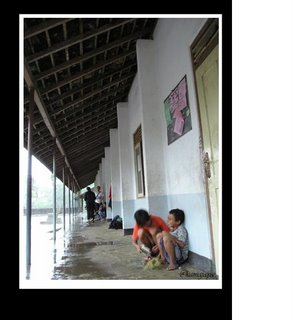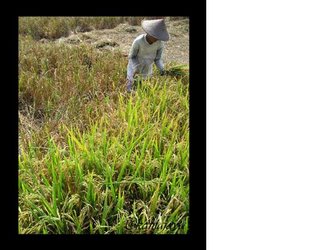Biking with photo hunting? Why not? This activity is doable at weekend or holiday. Well, actualy not only biking could be done same time with photo hunting, but other activities too, such like hiking, and even diving!
Yes, beside increasing our health, we would produce many kind of photos for phortofolio. But remember, before we do this, we should observe the field that we re gonna through with the bike. This relates to objects we're gonna hunt and the field condition.
For young people who have great stamina, biking through extrem field would be quait chalenge. But for those who get old with less stamina, they do biking as a light activity, so they would through easy terrain.
So, make your mind, for those biking around the town which usually has flat terrain, so many objects we could shoot, start from market, old buildings, train station, people's activities, and still many more! For those biking around village which usually have tougher terrain, people's activities are interesting objects to shoot
After observing the field we're gonna through, it would be good to plan route. And also check the bike's condition to make sure it's on top conditon, and if ti's not, make it so! parts like brake, tyres, wind pressure, etc. make sure they are in good condition to make the the hunt go well.
And now, preparing the camera. It doesn't matter what camera you use, is it ordinar digicam, DSLR, or even film camera. The important this is the condition of the camera, make sure it's in good condition. Also, pay attention to the bag where you keep the camera, it would be better if we use water resist bag with cushion to protect camera from shock and water. and when it's possible, dont use a huge bag for our confortable when paddling the bike. Dont forget to bring note, for those who like writing, the atmospehere along the trip would be inspiring to write.
Dont forget to bring snack and drink to keep you stay alive :), it's highly recommended carrying many food and water for traveling to remote area like biking to wood, where you will be a little hard to meet setlement. But when you biking around the town, you don't have to bring many of them, just carry some snacks and a tiny bootle of water with money of course, so you could buy them whey run out.
About clothes.. it would be better to wear clothes that prevent our body from getting heat quickly, we could wear bright color clothes to prevent sunlight absorbed by cloth. Remember, bright color absorbs less light then dark color do. And also pay attention to the fabric of cloth we wear, good fabric provide good air circulation, the heat will not traped behind the cloth which affect to our skin.
Here is a personal experience of the writer when biking aroud Bandung city....
It was cold at Caringin (located in Bandung). I planned biking while photo hunting that day. After all preparation were checked, such like top condition of mountain bike, note, snack and water inside a day pack, and of course my SLR camera with 35-70mm lens, I started to paddle. I planned to visit Soreang area.
The area I visited have various people's unique activity.... Began by entering Cigondewah teritory where Sentra Wisata Belanja exist. Here, we could find people's activities in trading. Goods that trade are textile with many kinds and motif. If we good at bargaining, we would have a good quality textile with low price.
After passed Cigondewah, I found a nice moment : farmers harvesting leafy vegetable. I was at Sadang teritory, in Boundary between Kota Bandung and Kabupaten Bandung. Generally farmers here worked not on their own land, but hire land. There were many good moments could be shot by my camera.
I moved on to Mahmud teritory inside Kabupaten Bandung, along the road i observe a raising industrial activity, which is HAT. People here are wellknown as creative people, they made hats using various fabric from waste factory. In their hand, that waste become a useful thing.....
Next route was to Nanjung, where I could see brick industries. We were avle to see brick making provide by locals, started from preparing material, forming, drying, untill roasting.
Plenty photos I'd created, well... not bad to make a photo essay. It was noon already and I had my lunch there, before biking to Gunung Singa Soreang, finish point ot the trip, where we could enjoy view of Bandung city.
Along the way, there were so many photos I made with many kinds of theme. Al least I visited four teritory through one trip with many photos I got, plus I had my body a little more health, hehe
Remember... keep shooting and shooting
Wassalam
Medan, Sunday 9th of April 2006
by : Arief Kamajaya, freelance photographer
Read More...

 You should consider about diafragma too when picking lens for your camera. When you shoot fast moving object alot, so 2,8 diafragma is good choice. It's different when you taking landscape image, it doesnt have to open diafragma too wide. Note that the more a lens support wide open diafragma, the more price you have to pay, and it goes along with the weigh.
You should consider about diafragma too when picking lens for your camera. When you shoot fast moving object alot, so 2,8 diafragma is good choice. It's different when you taking landscape image, it doesnt have to open diafragma too wide. Note that the more a lens support wide open diafragma, the more price you have to pay, and it goes along with the weigh.





